steering wheel Lexus GX470 2007 Instrument cluster / LEXUS 2007 GX470 OWNER'S MANUAL (OM60C64U)
[x] Cancel search | Manufacturer: LEXUS, Model Year: 2007, Model line: GX470, Model: Lexus GX470 2007Pages: 436, PDF Size: 11.52 MB
Page 2 of 436
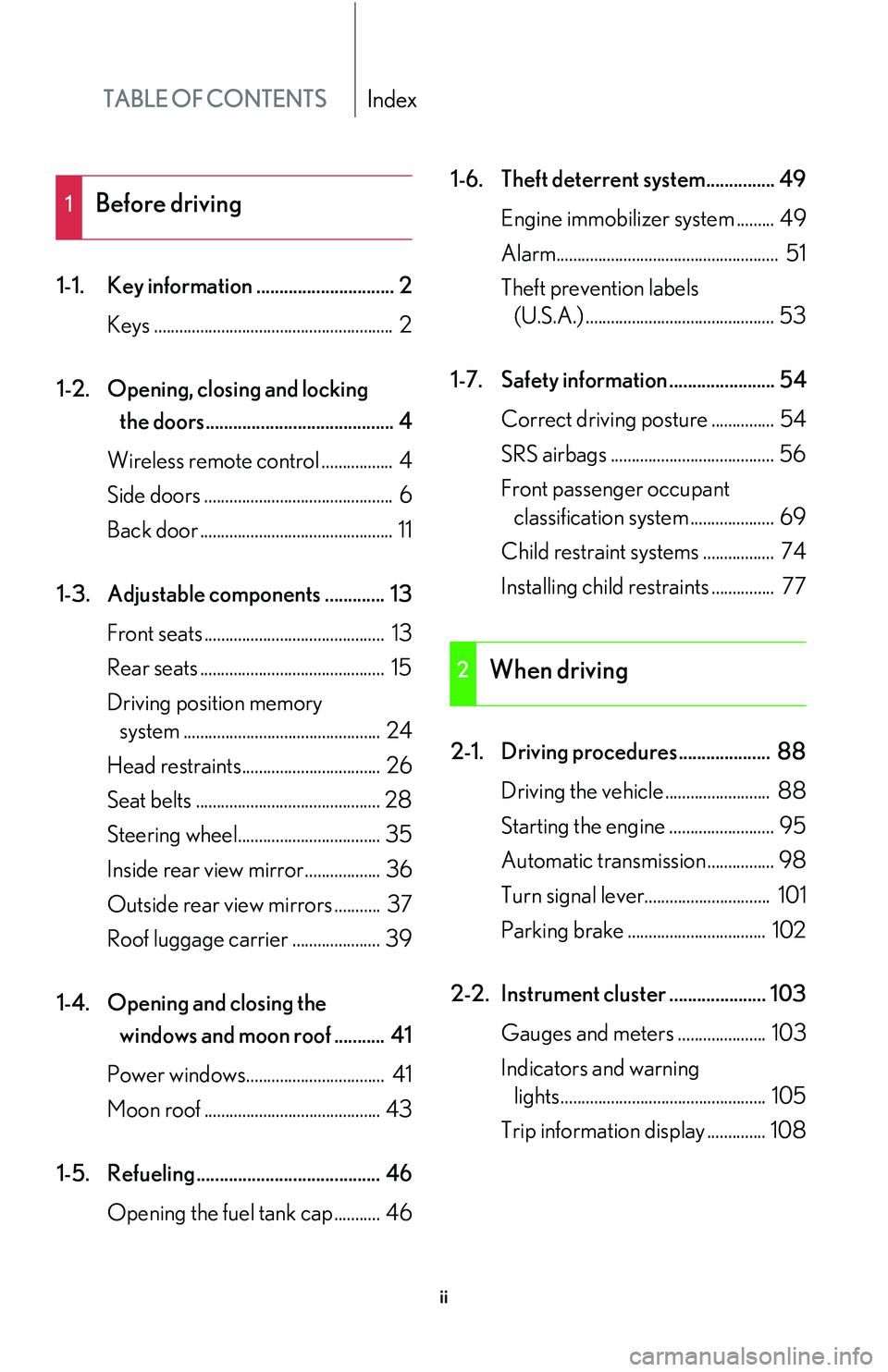
TABLE OF CONTENTSIndex
ii
1-1. Key information .............................. 2Keys ......................................................... 2
1-2. Opening, closing and locking the doors......................................... 4
Wireless remote control ................. 4
Side doors ............................................. 6
Back door .............................................. 11
1-3. Adjustable components ............. 13 Front seats ........................................... 13
Rear seats ............................................ 15
Driving position memory system ............................................... 24
Head restraints................................. 26
Seat belts ............................................ 28
Steering wheel.................................. 35
Inside rear view mirror.................. 36
Outside rear view mirrors ........... 37
Roof luggage carrier ..................... 39
1-4. Opening and closing the windows and moon roof ........... 41
Power windows................................. 41
Moon roof .......................................... 43
1-5. Refueling ........................................ 46 Opening the fuel tank cap........... 46 1-6. Theft deterrent system............... 49
Engine immobilizer system ......... 49
Alarm..................................................... 51
Theft prevention labels (U.S.A.) ............................................. 53
1-7. Safety information ....................... 54 Correct driving posture ............... 54
SRS airbags ....................................... 56
Front passenger occupant classification system .................... 69
Child restraint sy stems ................. 74
Installing child restraints ............... 77
2-1. Driving procedures.................... 88 Driving the vehicle ......................... 88
Starting the engine ......................... 95
Automatic transmission................ 98
Turn signal lever.............................. 101
Parking brake ................................. 102
2-2. Instrument cluster ..................... 103 Gauges and meters ..................... 103
Indicators and warning lights................................................. 105
Trip information display .............. 108
1Before driving
2When driving
Page 3 of 436
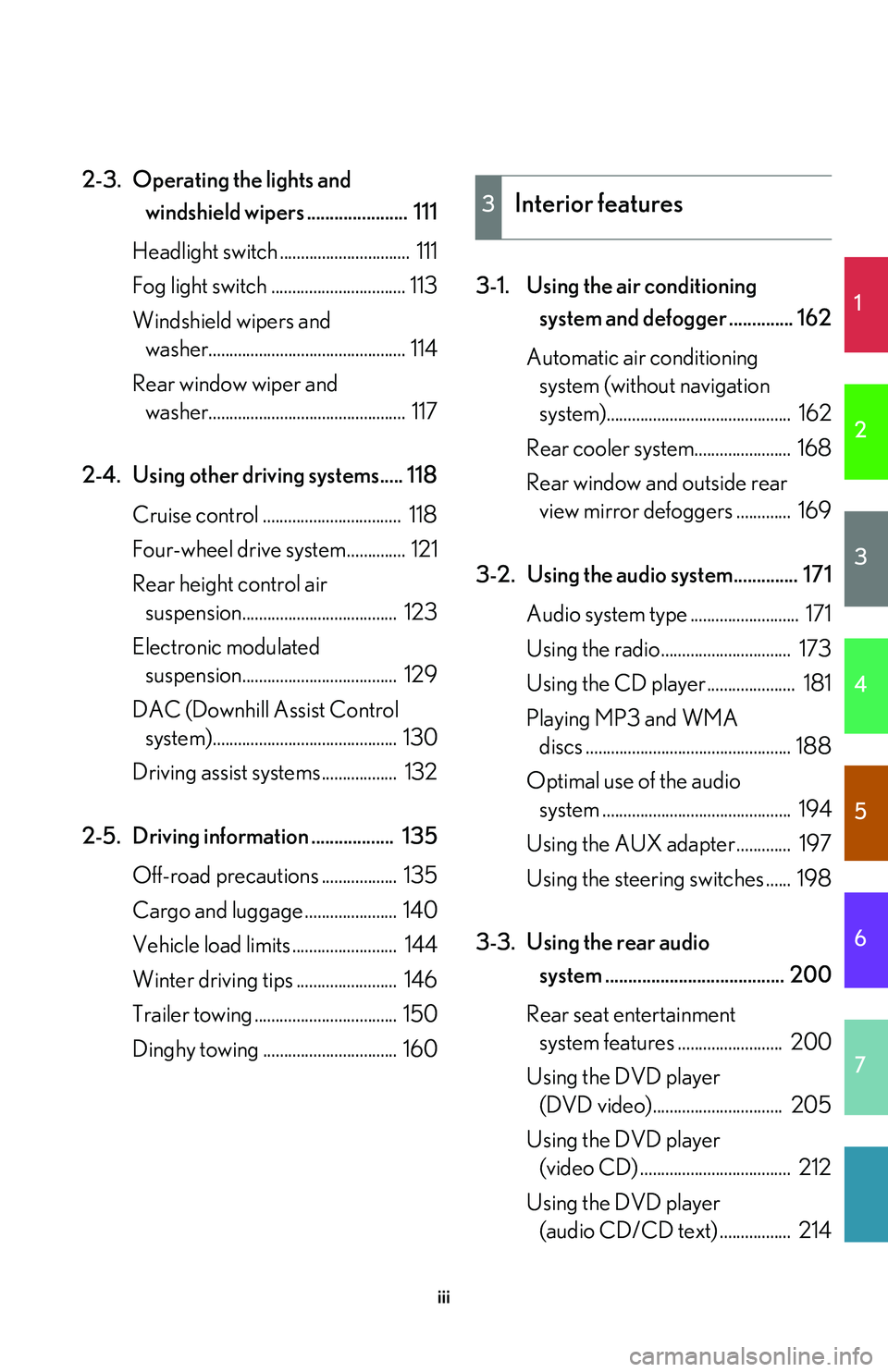
1
2
3
4
5
6
7
iii
2-3. Operating the lights and windshield wipers ...................... 111
Headlight switch ............................... 111
Fog light switch ................................ 113
Windshield wipers and washer............................................... 114
Rear window wiper and washer............................................... 117
2-4. Using other driving systems..... 118 Cruise control ................................. 118
Four-wheel drive system.............. 121
Rear height control air suspension..................................... 123
Electronic modulated suspension..................................... 129
DAC (Downhill Assist Control system)............................................ 130
Driving assist systems.................. 132
2-5. Driving information .................. 135 Off-road precautions .................. 135
Cargo and luggage ...................... 140
Vehicle load limits ......................... 144
Winter driving tips ........................ 146
Trailer towing .................................. 150
Dinghy towing ................................ 160 3-1. Using the air conditioning
system and defogger .............. 162
Automatic air conditioning system (without navigation
system)............................................ 162
Rear cooler system....................... 168
Rear window and outside rear view mirror defoggers ............. 169
3-2. Using the audio system.............. 171 Audio system type .......................... 171
Using the radio............................... 173
Using the CD player..................... 181
Playing MP3 and WMA discs ................................................. 188
Optimal use of the audio system ............................................. 194
Using the AUX adapter ............. 197
Using the steering switches ...... 198
3-3. Using the rear audio system ....................................... 200
Rear seat entertainment system features ......................... 200
Using the DVD player (DVD video)............................... 205
Using the DVD player (video CD) .................................... 212
Using the DVD player (audio CD/CD text) ................. 214
3Interior features
Page 21 of 436
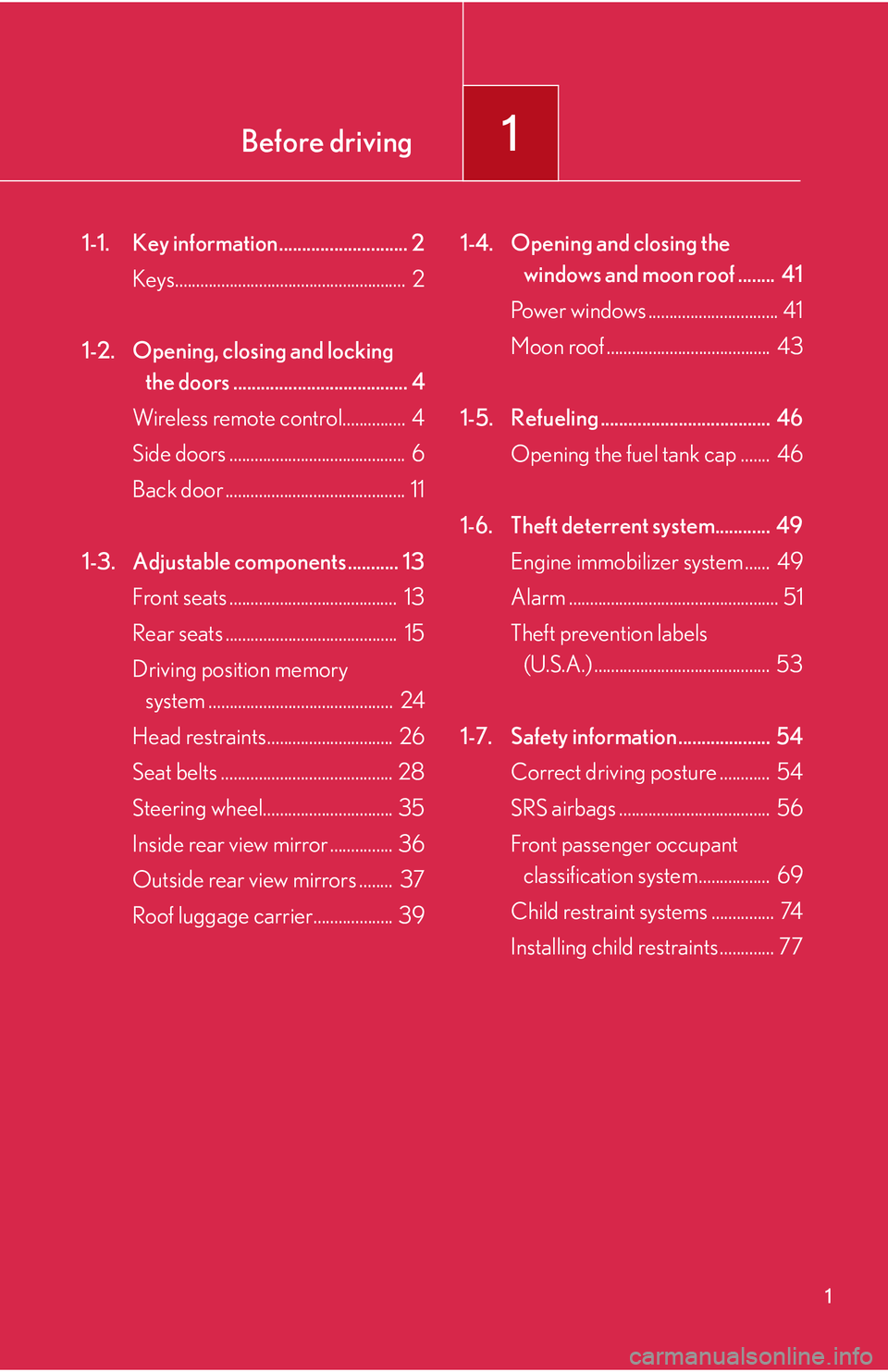
Before driving1
1
1-1. Key information............................ 2Keys....................................................... 2
1-2. Opening, closing and locking the doors ...................................... 4
Wireless remote control............... 4
Side doors .......................................... 6
Back door ........................................... 11
1-3. Adjustable components ........... 13 Front seats ........................................ 13
Rear seats ......................................... 15
Driving position memory system ............................................ 24
Head restraints.............................. 26
Seat belts ......................................... 28
Steering wheel............................... 35
Inside rear view mirror ............... 36
Outside rear view mirrors ........ 37
Roof luggage carrier................... 39 1-4. Opening and closing the
windows and moon roof ........ 41
Power windows ............................... 41
Moon roof ....................................... 43
1-5. Refueling ..................................... 46 Opening the fuel tank cap ....... 46
1-6. Theft deterrent system............ 49 Engine immobilizer system ...... 49
Alarm .................................................. 51
Theft prevention labels (U.S.A.) .......................................... 53
1-7. Safety information .................... 54 Correct driving posture ............ 54
SRS airbags .................................... 56
Front passenger occupant classification system................. 69
Child restraint systems ............... 74
Installing child restraints ............. 77
Page 44 of 436
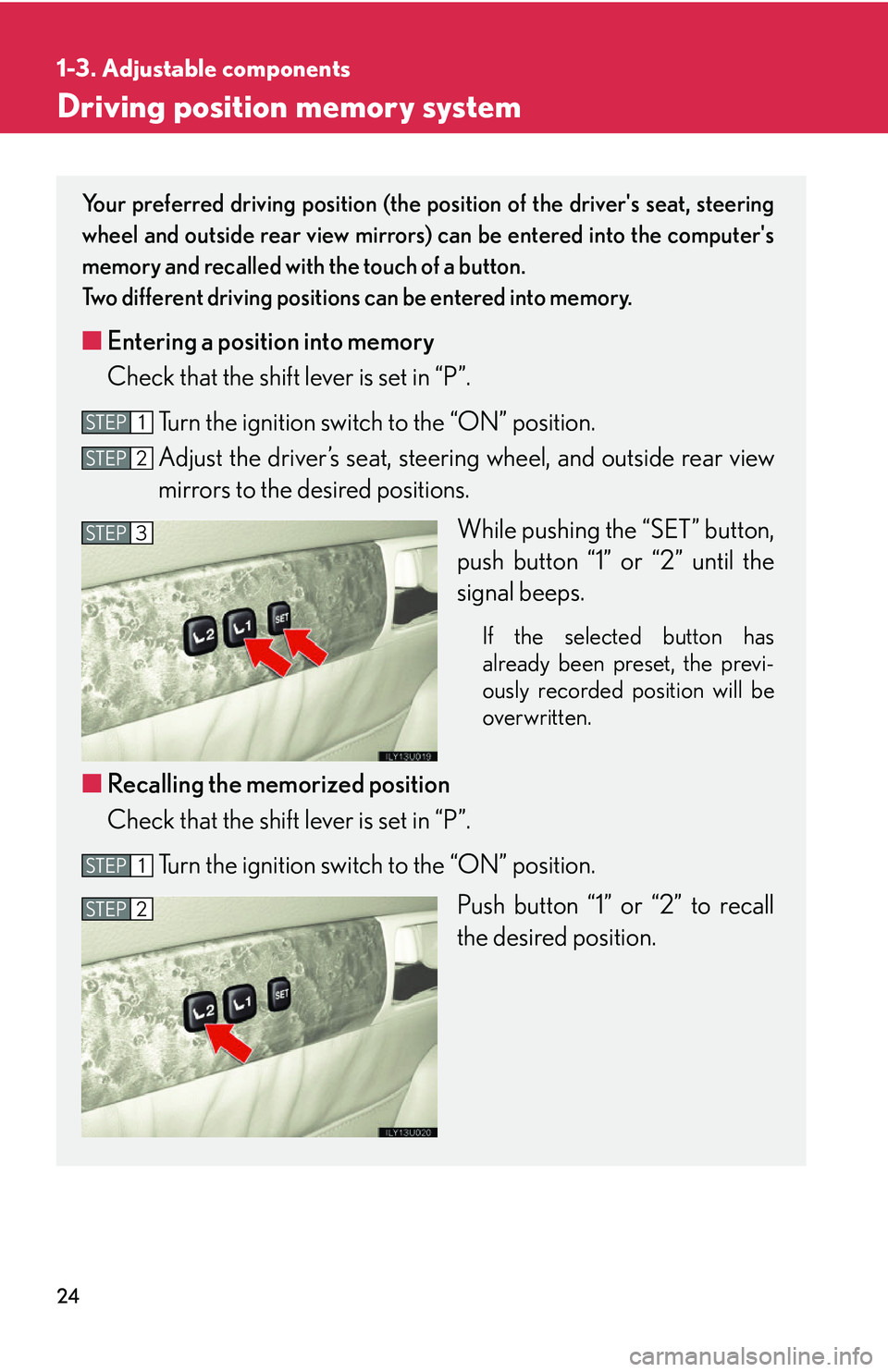
24
1-3. Adjustable components
Driving position memory system
Your preferred driving position (the position of the driver's seat, steering
wheel and outside rear view mirrors) can be entered into the computer's
memory and recalled with the touch of a button.
Two different driving positions can be entered into memory.
■Entering a position into memory
Check that the shift lever is set in “P”.
Turn the ignition switch to the “ON” position.
Adjust the driver’s seat, steeri ng wheel, and outside rear view
mirrors to the desired positions.
While pushing the “SET” button,
push button “1” or “2” until the
signal beeps.
If the selected button has
already been preset, the previ-
ously recorded position will be
overwritten.
■Recalling the memorized position
Check that the shift lever is set in “P”.
Turn the ignition switch to the “ON” position. Push button “1” or “2” to recall
the desired position.
STEP1
STEP2
STEP3STEP3
STEP1
STEP2
Page 45 of 436

25
1-3. Adjustable components
1
Before driving
■Retained accessory power
Each memorized position (except for the tilt and telescopic steering column) can
be activated within 30 seconds after the driver’s door is opened, even if the key is
not in the ignition switch.
■If any position memory button is push ed while the adjustments are being made
The operation will stop. To reactivate the system, push the button again.
■If the battery is disconnected
The memorized positions must be reset be cause the computer's memory is erased
when the battery is disconnected.
CAUTION
■Seat adjustment caution
Take care during seat adjustment that the seat does not strike the rear passenger or
squeeze your body against the steering wheel.
If this happens, you can stop the movement by pressing another seat position mem-
ory button.
Page 55 of 436
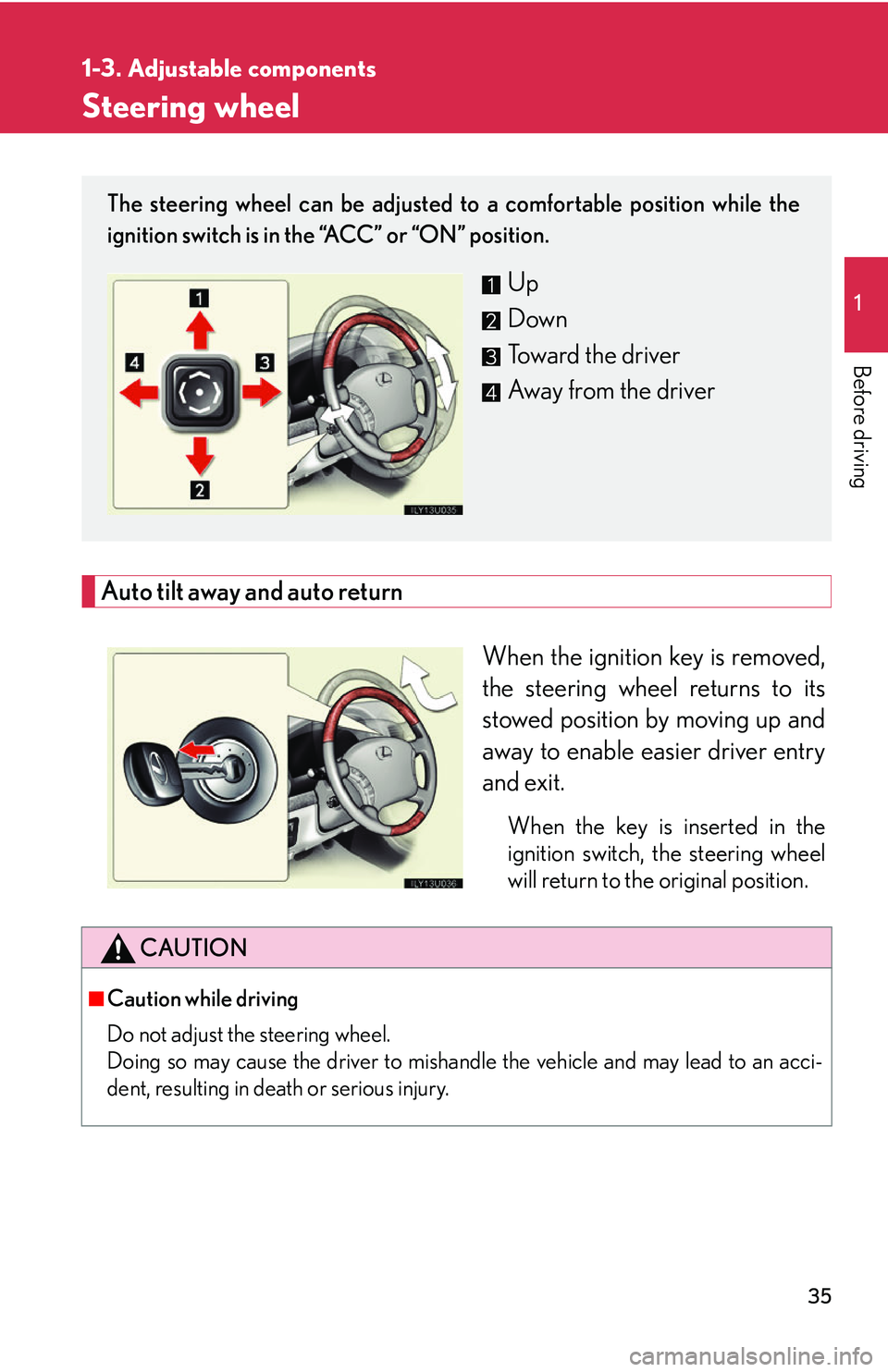
35
1
1-3. Adjustable components
Before driving
Steering wheel
Auto tilt away and auto returnWhen the ignition key is removed,
the steering wheel returns to its
stowed position by moving up and
away to enable easier driver entry
and exit.
When the key is inserted in the
ignition switch, the steering wheel
will return to the original position.
The steering wheel can be adjusted to a comfortable position while the
ignition switch is in the “ACC” or “ON” position.
Up
Down
Toward the driver
Away from the driver
CAUTION
■Caution while driving
Do not adjust the steering wheel.
Doing so may cause the driver to mishandle the vehicle and may lead to an acci-
dent, resulting in death or serious injury.
Page 74 of 436

54
1-7. Safety information
Correct driving posture
Drive with a good posture as follows:
Sit upright and well back in
the seat.
Adjust the position of the seat
forward or backward to
ensure the pedals can be
reached and easily
depressed to the extent
required. (P. 1 3 )
Adjust the seatback so that
the controls are easily opera-
ble.
Adjust the tilt and telescopic
positions of the steering
wheel downward so the air-
bag is facing your chest.
( P. 3 5 )
Lock the head restraint in
place with the center of the
head restraint closest to the
top of your ears. ( P. 2 6 )
Wear the seat belt correctly.
( P. 2 8 )
Page 78 of 436

58
1-7. Safety information
The main SRS airbag system components are shown above. The SRS air-
bag system is controlled by the airb ag sensor assembly. The airbag sen-
sor assembly consists of a safing sensor and an airbag sensor.
In certain types of severe frontal or side impacts, the SRS airbag system
triggers the airbag inflators. A chemica l reaction in the inflators quickly
fills the airbags with non-toxic gas to he lp restrain the motion of the occu-
pants.
■If the SRS airbags deploy (inflate)
●Bruising and slight abrasion s may result from contact with a deploying (inflating)
SRS airbag.
●A loud noise and white powder will be emitted.
●Parts of the airbag module (steering wheel hub, airbag cover and inflator) as
well as the front seats, and parts of the front pillar and roof side rail, may be hot
for several minutes. The airbag itself may also be hot.
●The windshield may crack.
Page 82 of 436
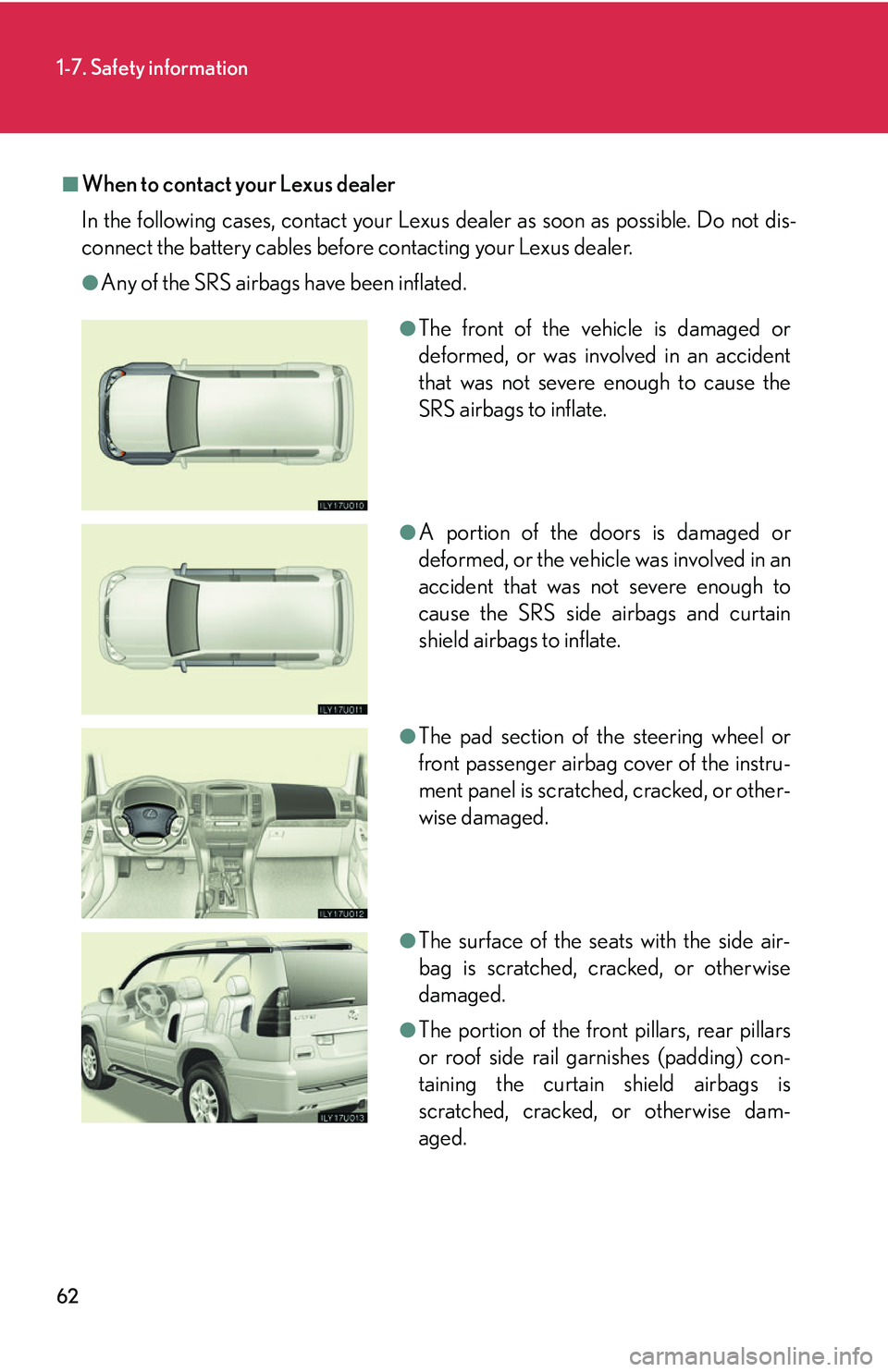
62
1-7. Safety information
■When to contact your Lexus dealer
In the following cases, contact your Lexus dealer as soon as possible. Do not dis-
connect the battery cables before contacting your Lexus dealer.
●Any of the SRS airbags have been inflated.
●The front of the vehicle is damaged or
deformed, or was involved in an accident
that was not severe enough to cause the
SRS airbags to inflate.
●A portion of the doors is damaged or
deformed, or the vehicle was involved in an
accident that was not severe enough to
cause the SRS side airbags and curtain
shield airbags to inflate.
●The pad section of the steering wheel or
front passenger airbag cover of the instru-
ment panel is scratched, cracked, or other-
wise damaged.
●The surface of the seats with the side air-
bag is scratched, cracked, or otherwise
damaged.
●The portion of the front pillars, rear pillars
or roof side rail garnishes (padding) con-
taining the curtain shield airbags is
scratched, cracked, or otherwise dam-
aged.
Page 83 of 436

63
1-7. Safety information
1
Before driving
CAUTION
■SRS airbag precautions
Observe the following precautions regarding the airbags. Failure to do so may
cause death or serious injury.
●The driver and all passengers in the vehicle must wear their seat belts properly.
The SRS airbags are supplemental devices to be used with the seat belts.
●The SRS driver airbag deploys with considerable force, and can cause death or
serious injury especially if the driver is very close to the airbag. The National
Highway Traffic Safety Administration (“NHTSA”) advises:
Since the risk zone for driver airbag is th e first 2 - 3 in. (50 - 75 mm) of inflation,
placing yourself 10 in. (250 mm) from your driver airbag provides you with a
clear margin of safety. This distance is measured from the center of the steering
wheel to your breastbone. If you sit less than 10 in. (250 mm) away now, you can
change your driving position in several ways:
• Move your seat to the rear as far as you can while still reaching the pedals
comfortably.
• Slightly recline the back of the seat. Al though vehicle designs vary, many driv-
ers can achieve the 10 in. (250 mm) distance, even with the driver seat all the
way forward, simply by reclining the back of the seat somewhat. If reclining
the back of your seat makes it hard to see the road, raise yourself by using a
firm, non-slippery cushion, or raise the seat if your vehicle has that feature.
• If your steering wheel is adjustable, ti lt it downward. This points the airbag
toward your chest instead of your head and neck.
The seat should be adjusted as recommended by NHTSA above, while still main-
taining control of the foot pedals, steering wheel, and your view of the instrument
panel controls.